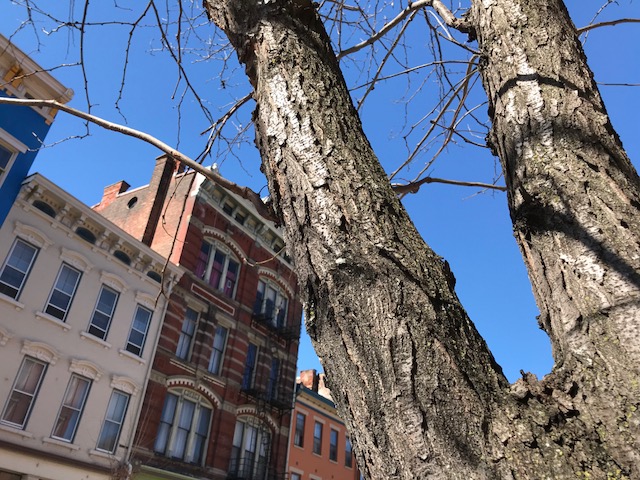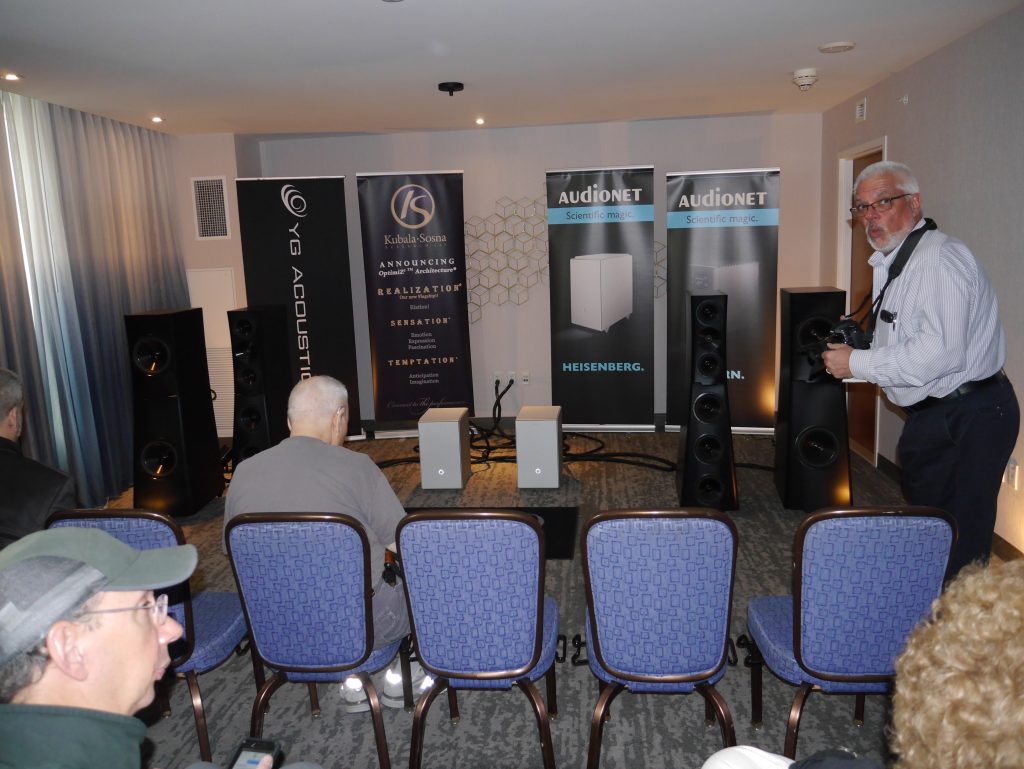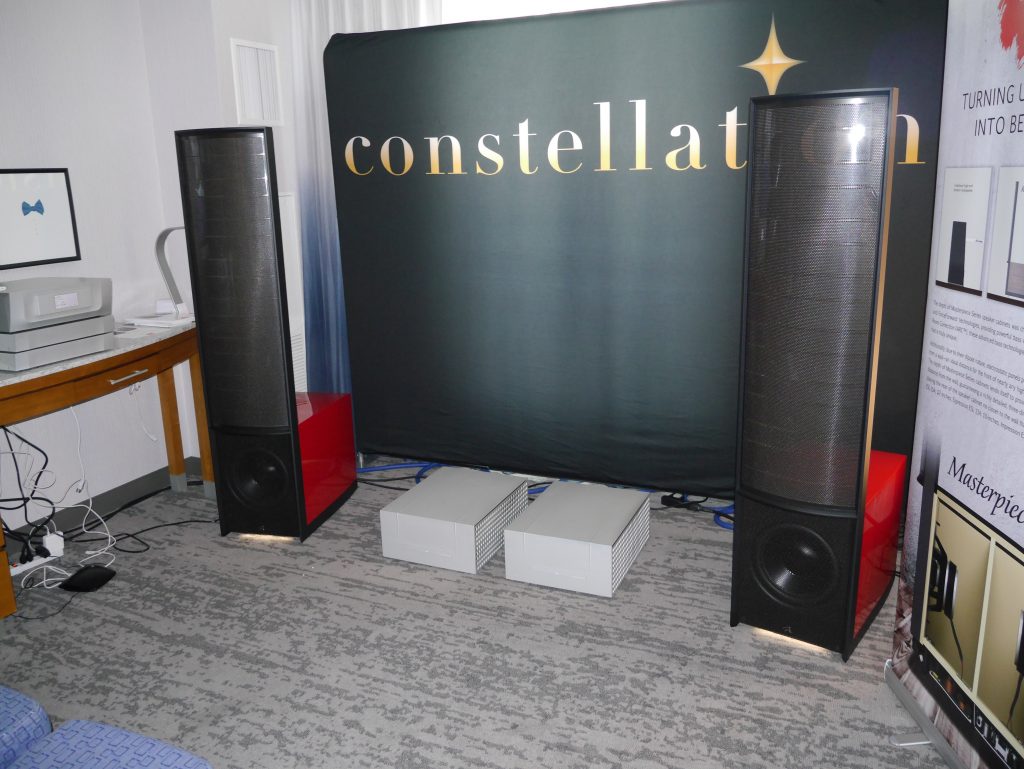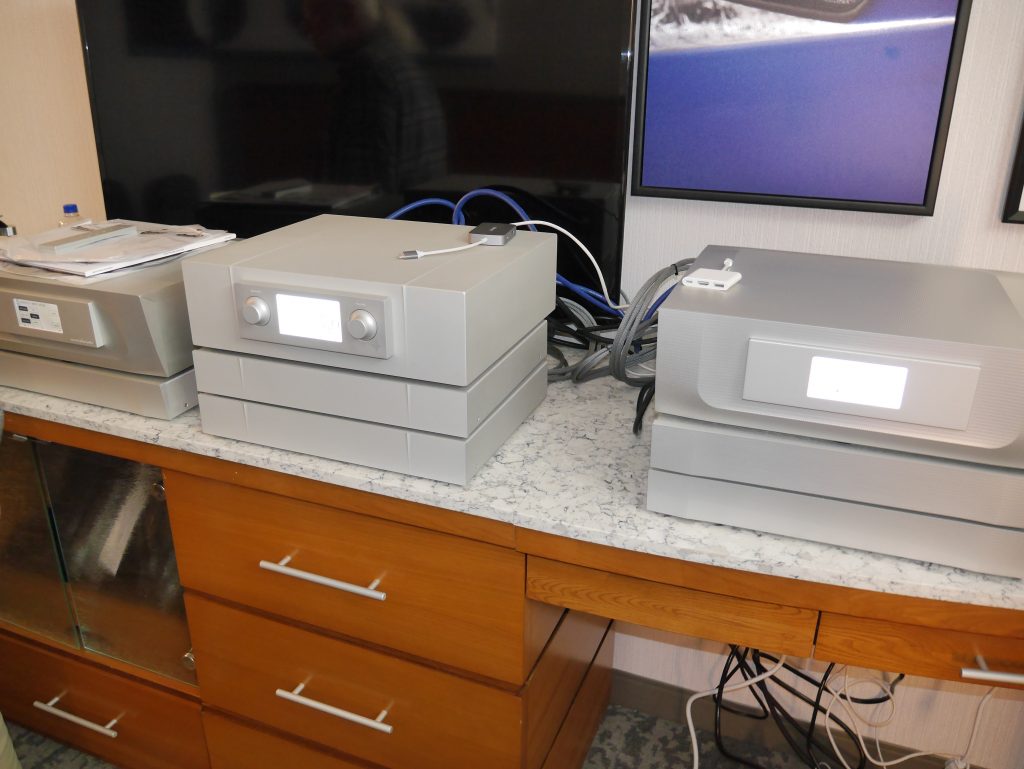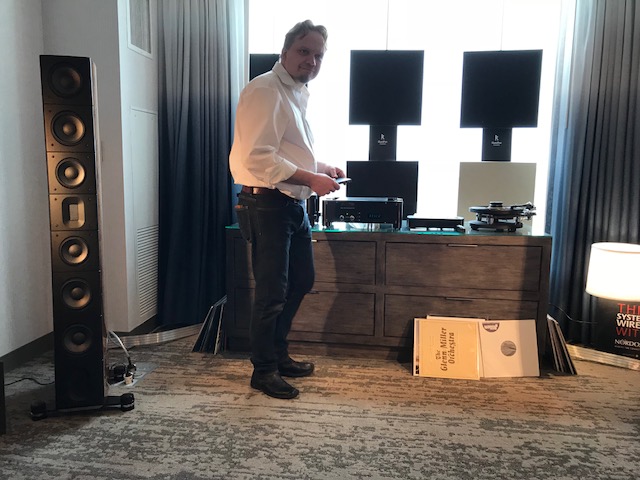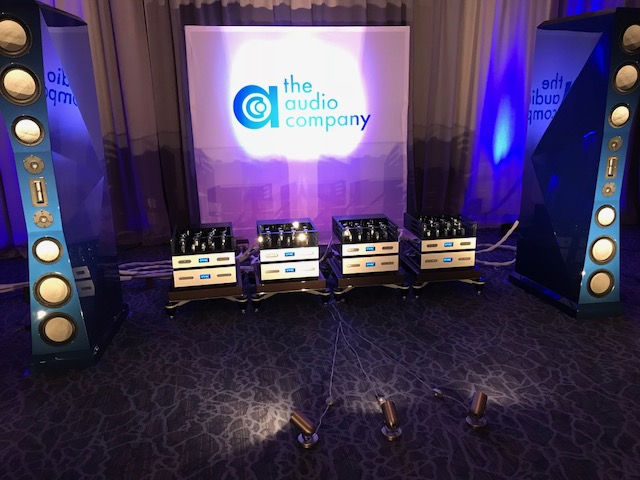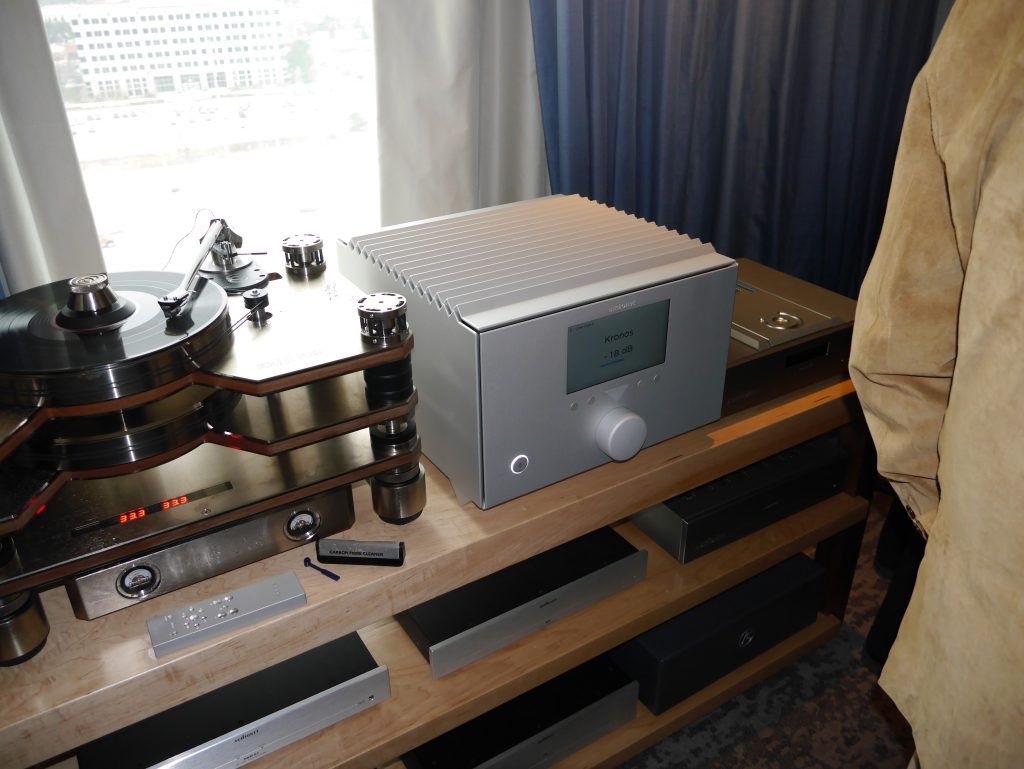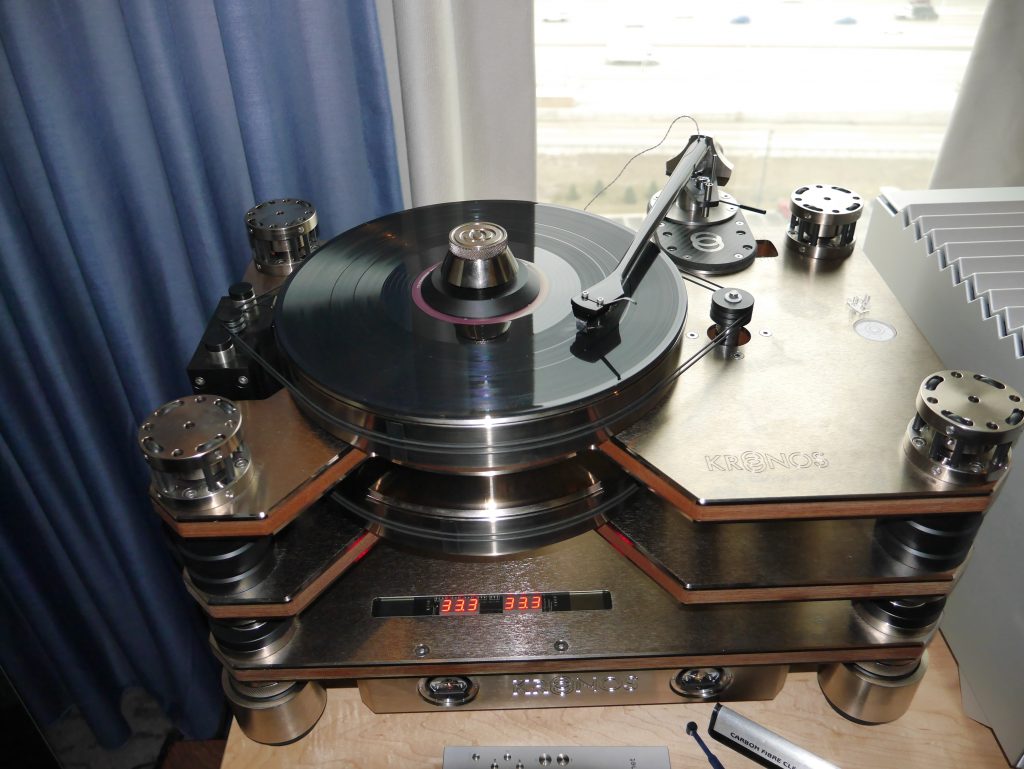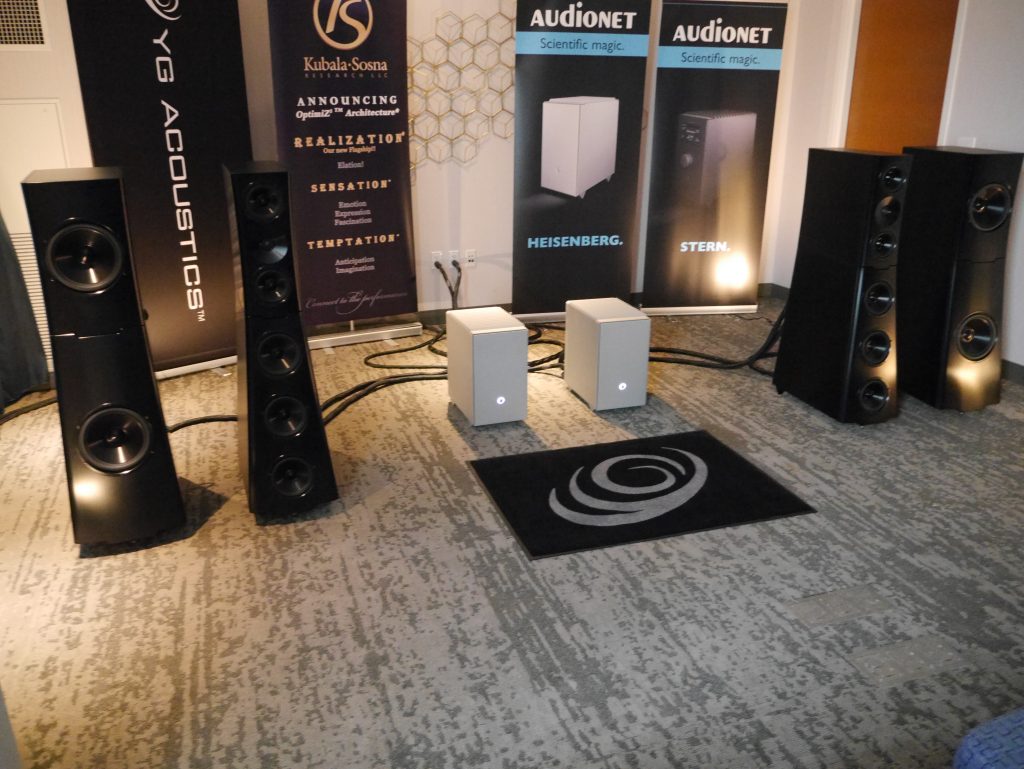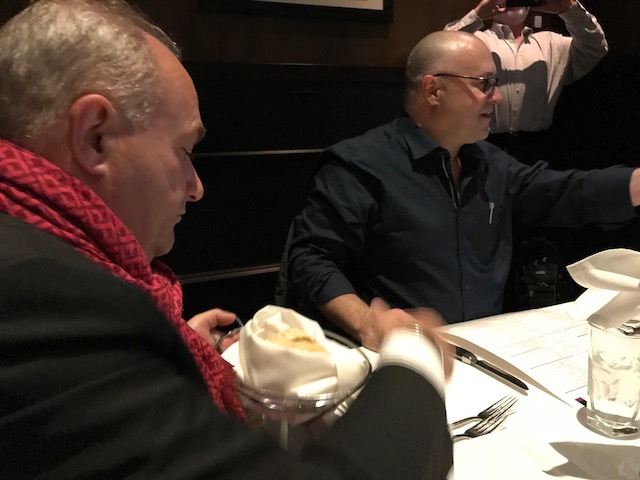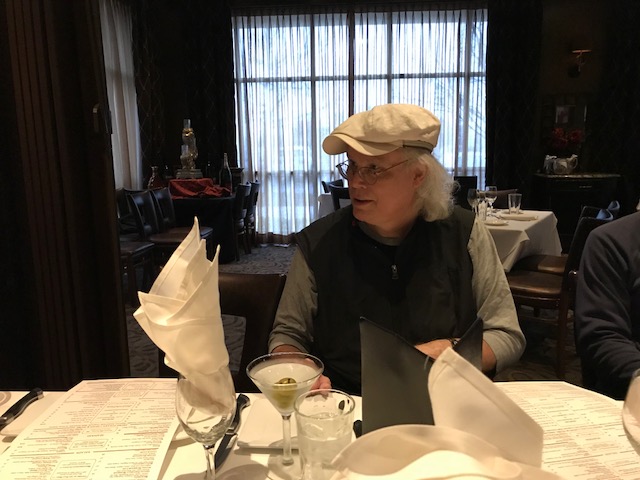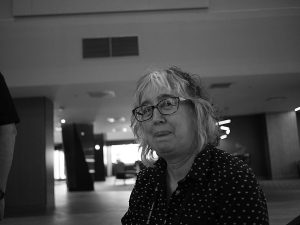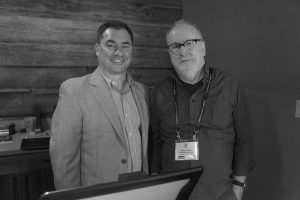For 2018, AXPONA moved to a bigger, shinier, swankier venue, showed up with real attitude and renewed swagger, and hosted noticeably bigger crowds. The Renaissance Schaumburg Hotel and Convention Center, a ginormous, and ginormously over-the-top Bauhaus-influenced conference center, blessed with the amenities and exhibition capacity to handle a show the size of AXPONA, replaces the delightful but amenity and space-challenged Rosemont Westin as the Big A's chosen party spot.
More restaurant seating and more common area lounge spaces undoubtedly made everyone's stay more manageable, pleasant, and less stressful. But attendees still routinely encountered 10 to 15 minute waits at hotel eateries, and relatively long elevator waits during peak showtime hours. Still, waits were noticeably shorter than the interminable Westin elevator delays. OTOH, the weather just plain sucked, the weatherman's late week promise of clear skies and temps ranging from the mid-40s to the low 70s hijacked by cold, wind-driven rains, snow flurries, and grey skies.
Chicago's skies did not look like this
To make matters worse, my dumb-ass packed a seersucker sport coat instead of my warm, tried-and-true, all-weather blue wool blazer! Oh, well. At least the cabbies were honest, the Chicago-area traffic manageable, and the O'Hare crowds well-controlled. And I got to hang out with Greg Weaver again.
Even the TSA folks were nice ("We're TSA, dog. We f---in' handle shit!").
OTOH, the new AXPONA show model faces some stiff challenges as it moves to secure its status as the second most influential gathering of its type in the world (behind High End Munich). First, with a few notable exceptions, the Renaissance hotel rooms were a bit smaller than those at the dear old Westin. Unfortunately, way too many exhibitors showed up with man-coffins instead of monkey-caskets, forcing on the rest of us tizzy, white-hot top ends, uncontrolled bass boom, and generally crappy sound.
Second, at least according to the exhibitors I spoke with, costs shot up steeply. Fees to secure banner space in central locations quadrupled in some instances. Third, more than a few exhibitors complained of strong-arm tactics that required them to agree to rent space next year to secure a room, or rooms, this year, despite their having neither seen, nor more importantly, heard how the new spaces looked, and sounded.
If true, these accounts potentially reveal a show organizer and/or venue management team a bit out of touch with their customer's (the exhibitors) actual bottom lines, and more than a bit clueless as to the overall economic health of the high-end industry. The AXPONA team and venues like the Renaissance need to bear in mind that most show exhibitors are typically not of the deep pocket variety. The small importer/distributor, the manufacturer with only two employees, the local retailer that teams with a manufacturer or distributor to share room costs, each struggle daily to make ends meet. They, along with their loyal customer base, most of whom are also not wealthy, represent the backbone of the high end.
The presence of $50K turntable/tonearm combinations, $100K+ loudspeakers, and interconnects that cost as much as a nice Honda Accord doesn't alter this reality.
Let me share a story that amplifies this truth. A well-known dealer, whom I have known for years, disclosed that he had to sell the turntable review sample he had earlier set aside for me, just to pay bills. He would need to build his cash reserves to secure a new review sample for me. I indicated that I was in no hurry to take delivery, and that we could revisit the issue six months from now, a position that obviously relieved my colleague and friend.
And while I'm certain that this retailer/distributor isn't starving, he runs a lean two-person shop, can't afford deep inventories, and must account for every penny he spends. This is not a person the expo organizers and the venue should see as a "deep pocket" operator, one who will happily agree to reserve a room for AXPONA 2019 without having seen or heard the room he secured for 2018.
Even the well-capitalized mega-firms that exhibit in the massive ground floor and mezzanine spaces often share costs with other retailers, distributors, and manufacturers to offset the high price of exhibiting.
In short, no AXPONA exhibitor sells one thousand-dollar cell phones by the millions each year. Show pricing and exhibition policies and strategies need to understand the economic realities of the high-end as it exists today, not as it appears to those unfamiliar with its inner dynamics and real bottom lines.
Enough preaching! On with the show!
MJ's Best of Show Contenders: The Mega-Systems
Each of the mega-systems featured here (meaning those systems costing more than my first house) typify what the burgeoning hedge fund manager or young neurosurgeon can put into their custom-designed listening rooms. To varying degrees, each mega-system can deliver the dynamic punch, frequency extension, refinement, drama, and musical scaling we routinely associate with the real thing, or at least approach that metric. They cost a pretty penny but deliver the musical goods in spades.
My "stealth-bomber" mega-system nod goes to the GamuT/Kyomi Audio/Pneuance Audio room. Pneuance manufactures an inventive and original line of pneumatic isolation pods (pNEUPODS) that use air bladders to decouple acoustically attached components (DACs, turntables, servers, preamplifiers, phono preamplifiers, and amplifiers) in all planes. In its product literature, Pneuance describes the rubber diaphragms used in its pNEUPODS as a "custom formulation that has been perfected for its purpose."
The pNEUPODS and (prototype Pneustand bamboo-shelved component rack, price TBD) allowed the companion GamuT gear, in classic stealth bomber fashion, to disappear utterly. The GamuT RS7i loudspeakers ($40K the pair), M250i mono blocks ($26K the pair), D3i preamplifier with phono board ($10,190), Pear Audio Kid Thomas table/Cornet 2 arm/My Sonic Lab Hyper Eminent combo ($15,475), with GamuT cables, Aurender A10 server ($5499), and Bricasti M1 LE Gold DAC ($16K) mesmerized yours truly.
The RS7i floor-standers displayed the same stunning musicality as the mighty Zodiacs I heard earlier this year in Greg Weaver's home, minus a bit of scale, drama, and protean bass crunch. Melody Gardot's The Rain sounded as palpably real as I have ever heard. "Stunning," read my notes. "A genuine Best in Show (BOS) contender".
My "sound of silence" mega-system shout goes out to the Constellation Audio crew. Constellation once again teamed up with Martin Logan and Constellation's sister company, Continuum Audio Labs, to deliver sound of such preternatural purity, noiselessness, and transparency that it left me slack-jawed. Constellation demoed its relatively new Revelation series gear (Pictor preamplifier, Andromeda phono preamplifier, Taurus Mono blocks), what demo-master Irv Gross described as the company's "sweet spot," along with Martin Logan Renaissance ESL 15A electrostatic-hybrids ($25k/pair) along with Continuum’s gorgeous, and gorgeous sounding, Obsidian turntable and Viper tonearm (around $50k for the combo plus Ortofon A95 cartridge).
This sweet combo sonically obliterated the walls of the compact hotel room. The 'stat-woofer blend sounded virtually seamless to my ears, with layered staging, and ghostly transparency (meaning the room and electronics were nowhere to be heard, but with no diminution whatsoever in image palpability and perceived solidity). Dean Martin (crooning "Blue Moon" from his Dream with Dean LP) literally awoke from the dead to caress my tired ears and soothe my weary soul.
My notes added: "Solid 3D imaging. Great focus and air. Superb transparency and 'stat/cone integration. The Constellation gear swung with the speed of a middle weight, the power of a cruiser weight, and the finesse of a 90 lbs. gymnast. A BOS contender".
Scaena Audio hands down wins my Star Trek "holodeck" award. Scaena's $75K "Iso-Linear Array" line source masterpieces with matching powered subs (2) did something no other system in my experience has ever done: placed Tomasz Stanko, John Surman, and the rest of Stanko's band (from Stanko's 1999 release From the Green Hill (ECM)) in the center of the room as living, breathing, 3D replicas of real musicians, not 2-dimensional simulacrums.
Oh, the system may have lacked some of the sheer weight and authority of the Audio Company/VSA/VAC set-up that I discuss below, and a bit of the pellucid clarity, air, and sweetness that the GTT Audio room exuded in spades (also discussed below), but no other system at the show placed the performers in the room in front of me to quite the degree that I experienced with the Scaena array.
Well done, gentlemen!
The Scaena team has graciously invited me to conduct an on-site review of their amazing "Iso-Linear Array" speaker system at the Scaena headquarters in South Florida, an offer I intend to take them up on (no way could the Scaena system fit in the New Apartment Lounge).
Look for my report over the summer, or early fall.
Doug "Fresh Prince" White, the man, the legend, and the creative soul behind The Voice That Is, once again beguiled listeners with his superb Tidal-based set-up. Year after year, crappy room after crappy room, Doug manages, like an alchemist from the ancient world, to turn sonic lead into musical gold (thereby meriting his induction into the "Order of the Alchemists"). And like the ELAC team to be spotlighted in Part 2, the classy Mr. White personally emailed to me a detailed listing of the components (and their prices) featured in his room.
Here goes: TIDAL Audio Speaker Piano G2, exhibited here in rare dark Ebony Macassar (it was simply gorgeous); TIDAL Audio Impulse Dual-Mono Amplifier $35,200; TIDAL Audio Preos Preamplifier w/DAC & Phono-stage $32,900; TIDAL Audio Reference Cables (price varies with type and length); Antipodes DX Gen 3 Music Server $7750 - $17,200 (1TB - 8TB); Dynamic Design Neutron SW16 Digital ~ 1.5M Power cord $7500; TW-Acustic Raven AC-1 Turntable $15,500, TW-Acustic 10.5 Tonearm $5500; Transfiguration Proteus Cartridge $6000.
Yup, expensive, pure and simple, as if you had to ask!
Doug played a pristine Johnny Hartman LP early Friday morning, the crooner’s smooth tones dusting off the lingering cobwebs still clouding my muddled brain. Smooth as silk, soulfully elegant, with incredible transparency, real tonal traction, and world-class articulation, Doug's superb set-up skills continue to show off one of the world's best speaker lines, the German designed and built Tidals, in their artfully best light. Alas, I owe Doug a bit of an apology. In my early morning stupor, I forgot to take pictures of the room. Oops!
Continuing the Pan-European theme, Benno Baun Meldgaard, Danish man of mystery and the new kid at team Raidho, was kind enough to demo for me the svelte Raidho D4.1 floor-standing loudspeakers ($125K the pair—ouch), these powered by Chord electronics and an SME 10 turntable/ Series 309 arm combo (plus Ortofon Cadenza Black MC).
The sound was shockingly fast, with near horn-like presence and dynamic swagger. The mid-bass sounded a bit thin (the Chord electronics are not known for their warmth), and the ribbon a touch hot, but this was still an electrifying listen. Tomasz Stanko and team materialized into the listening room in holographic relief, with only the last bit of natural warmth missing in action. Bass was deep, with good texture (albeit with a tad too much room-induced boom in the lowest octaves), and first-rate imaging (all on CD—I can't recall the player, but likely a Chord model based on my pictures). A lovely big band recording on vinyl sounded much more more natural over this system, with better bass control and superior midrange ease.
Downstairs the tiny, but hardly tiny sounding, Raidho D1.1 stand mounts ($22,900 the pair in their funky lime green painted finish), here driven by the new new Aavik U-150 integrated amplifier (Class D/300 wpc into 8 ohms/$12K) and Pear Audio Kid Howard table, rocked the house. The little Raidho's filled the room with "laser quick" sound, holographic staging, and spring-loaded dynamic snap. I rated inter-driver coherence as very high, with no harshness or glare. Again, certainly not cheap, but fun as hell and musically invigorating.
My "burning down the house" choice threw modesty, financial restraint, and any hint of modesty out the proverbial window. Atlanta retailer extraordinaire the Audio Company, along with the sonic wizards at Von Schweikert Audio and VAC (Valve Amplification Company), stole the show, at least for those fortunate few who have the space, the scratch, and the nagging desire to replicate the sound of a great symphony orchestra or rock band in their living rooms. VSA's towering Ultra 11s (don't ask the price) swung with the speed, power, authority, and pinpoint accuracy of the great Mohammed Ali, and sound-staged with a sweep and scale so commandingly grand and self-assured, that well-recorded symphonic works genuinely came alive, if not quite crossing the chimerical "real-thing" threshold.
Four towering VAC 450 Statement iQ amplifierss (1 amp driving a single mid-tweet array, the other a single bass array, I suspect), these in turn driven by an all-VAC Statement Line/Statement Phono front end, a gaggle of esoteric looking Esoteric digital sources, and of course, the Kronos Pro turntable with new carbon fiber arm board, Black Beauty tonearm, and reference grade Air Tight phono cartridge, fed the 11s a signal as pristinely pure and natural as spring water.
A seemingly mile-long loom of top-flight MasterBuilt Audio cables held everything together (a $400K loom, I'm told).
I heard greatness Thursday night in the company of Greg Weaver, VSA's Leif Swanson, and Damon Von Schweikert, the Audio Company team, and, I believe, at least one VAC representative, but my notes here are sketchy. The Domino track from my Tomasz Stanko CD really soared in this space (the exhibitors spent the better part of a day taming ruthless room-induced bass resonances prior to showtime), filling the back third of the room with Stanko's first-rate band, this highlighted by John Surman's wispy, earthy baritone sax solos. Goosebumps, indeed!
I returned briefly on Saturday night to hear Master of Ceremonies Greg Weaver spin vinyl, wax enthusiastically about what he (and the rest of us) were hearing, and witness Sir Gregor rapturously offering a vocal and joyous "f#!k me!" to the audio gods in praise of the great sound. He even waved his arms about like a true believer. This man takes his audio seriously, friends!
Along the way, I got to meet the lovely Dave and Carol Clark face to face, hung out with my good buddy David Robinson, chewed the fat with Walter Swanbon of Fidelis Audio, and drank some outstanding single malt scotch. I had a blast! (and slept like a baby afterwards.)
BTW, the total system priced topped the $1.5 million mark. Keep buying lottery tickets is all I have to say.
Last, but certainly not least in my mega-system round-up, the 16th floor GTT Room, my "iron fist in a velvet glove" choice, surpassed musical expectations on almost every level. The GTT Room featured a gaggle of top-flight Audionet electronics (the Planck CD Player at $18,800, Ampere Power Supply for the CD Player at $11,200, the PAM G2 phono stage $10,100, EPX Power Supply for the Phono $10,100, the DNC Streaming DAC $10,100 and EPS G2 Power Supply for the DAC $4050, the Stern Linestage $45,000, and the colossal Heisenberg Mono Amplifiers at a sizzling $105,000 the pair), plus a host of other goodies.
The analogue front-end featured, what else, Kronos' best. The stunning Kronos Limited Edition Turntable ($48,000), Kronos Black Beauty Tonearm ($10,000), Kronos SCPS 1 Power Supply ($13,500), and Air Tight Opus 1 Cartridge ($15,000), together cost half as much as my first house. A sweet loom of Kubala-Sosna cables linked everything together (total loom price in the low 6 figure range), and connected amps to speakers, here the spooky-good YG Acoustics Sonja XV Jr. $189,600 towers (a 4-box affair).
This is clearly "if you have to ask" money, friend.
For the sensualists out there, you simply must see and touch the new Audionet Scientist Series gear to appreciate fully just how beautiful these components are to behold, and just how incredibly well-made and solid they feel to the touch. In all my years, I have yet to encounter gear of such striking visual élan and sheer tactile seductiveness.
The GTT Audio system provided a persuasive and sonically effective counter-argument to the Audio Company/VSA/VAC thesis. If the latter embraced the audio equivalent of Donald Rumsfeld's "shock and awe" philosophy of sound reproduction, the GTT system embodied what one might call the James Baker school: walk softly and carry a big ass stick. Baker, known in foreign affairs circles as a classic "iron fist in a velvet glove" diplomat, valued soft-sell persuasion over the threat (or use) of brute force, but would happily resort to force if necessary.
In Baker-like fashion, the GTT system spoke in almost hushed, reverential tones, celebrating micro-dynamic fluidity, delicacy, and almost preternatural sound-staging, over sheer gravity-defying force. Yet when called to do so, the YG towers (and Audionet amplifeirs) could (and did) rock, hitting with pile-driver impact and commanding authority. That they did so with a bit less visceral "oomph" than the Audio Company/VSA/VAC system merely highlights the different sonic philosophies of the systems at play.
My notes pretty much tell the tale here: "Preternatural air, with body, depth, and solidity. Superb bass textures. Surman's baritone sax solo on Domino (from my Tomasz Stanko CD) popped into place in the exhibition room with startling presence. The sound was richly textured with deeply layered sonority. Mid-bass was perhaps a tad full. But, goose bump city. Tomasz Stanko rocked. My overall BOS choice. "
Hats off to GTT commander-in-chief Bill Parish, Robert Hageman of Audionet, the irrepressible Dick Diamond of YG, and everyone else who made this my favorite room at the show. BTW: Bill, Dick, and Robert treated around 20 lucky souls to dinner on Friday night.
Guests included the mercurial Peter Breuninger of AV Showrooms fame, Greg Weaver (that guy won't let me be), Dr. David Robinson, and a merry group of fellow music lovers, staffers, and even customers, all too numerous to mention by name. These guys know how to throw a party!
More to come in Part 2!




